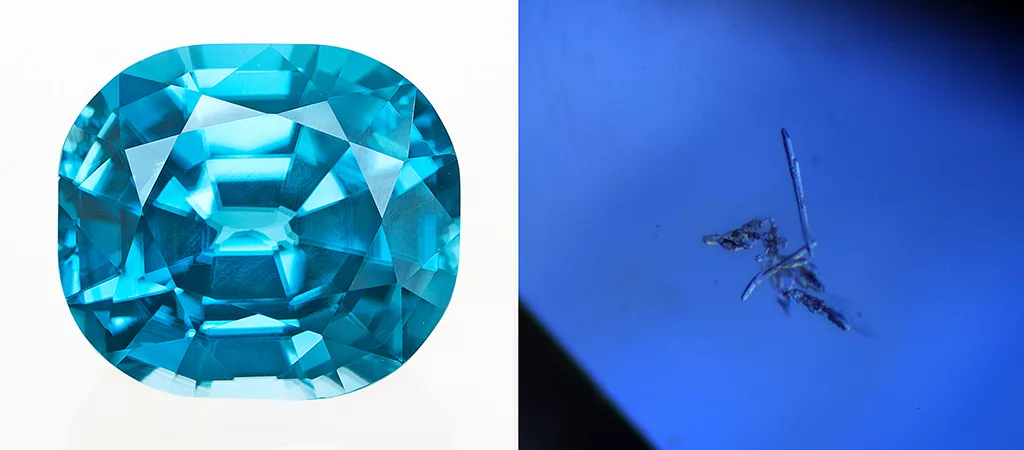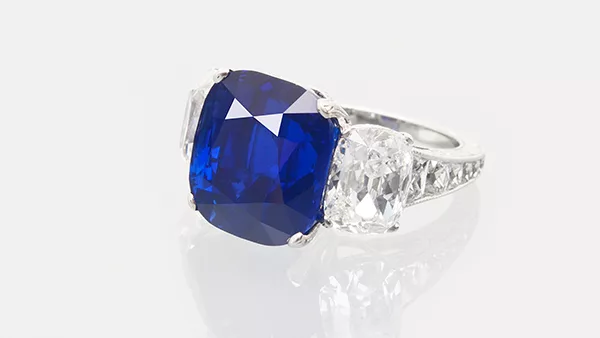
Zircon inclusion analysis for sapphire origin determination
by Dr. M.S. Krzemnicki, first published in Facette 27 (June 2021)

Zircon ZrSiO₄ a very intriguing mineral, not only because it can be used as an attractive gemstone (Figure 1) but also due to the fact that it can contain minute traces of radioactive elements (U, Th), which decay over time to lead (Pb) isotopes. As such, zircon grains or zircon inclusions provide geoscientists (and gemmologists) a very robust and well-studied tool for radiometric age dating of rocks, minerals or gems, and consequently also allow us to date dynamic geological processes which form these rocks and minerals (see also our articles about age dating in this SSEF Facette, pages 30-31).
As a side effect of this radioactive decay, the crystal structure of zircon is affected locally. This process is known as metamictization and also results in a gradual shift of physical properties (e.g. SG, RI), known and traditionally categorised by gemmologists as high-zircon or low-zircon. The metamictization of zircon has been extensively studied in scientific literature and its peak-broadening effect on Raman spectra of zircon is well documented (Nasdala et al. 1995, Zhang et al. 2000) as is an inverse sharpening effect of the Raman peaks by annealing of metamict zircons (Nasdala et al. 2001, Wang et al. 2006, Wanthanachaisaeng et al. 2006).
Since many years, the SSEF is using Raman spectroscopy of zircon inclusions as a very important method to detect heat treatment (see for example SSEF Facette No. 17, 2010, page 12), but also as a method to support origin determination of gemstones, notably ruby and sapphires.
In a recent research project, the SSEF teamed up with Dr. Wenxing Xu, gemmologist and researcher at the Gübelin Gemlab to establish a joint Raman database of zircon inclusions in sapphires with a well-documented geographic provenance.

As already known before (Block, 2011), the state of metamictization in zircons is also related to their geographic origin, mainly due to differences in their age of formation. Figure 2 shows a striking example of how Raman spectra on zircon inclusions can help to unambiguously separate sapphires from Kashmir from similar-looking velvety blue sapphires from Madagascar. As a geologically young formation, zircon inclusions in Kashmir sapphires reveal very narrow Raman peaks. The much older metamorphic sapphires from Madagascar, however, contain zircons which are distinctly more metamict and as a result they show Raman spectra with much broader Raman bands.
With the new study, we have been able to extend our database considerably, and thus to better document the usefulness and importance of Raman spectroscopic analyses on zircons as a meaningful tool for gemstone origin determination. Our latest scientific results have been recently published in the Journal of Ramanspectroscopy (Xu & Krzemnicki, 2021).
Interested readers will find more information about this paper here.

REFERENCES
Block T (2011) Raman spektroskopische Untersuchung von Zirkon- and Apatit-Einschlüssen in Saphiren verschiedener Lagerstätten, Master thesis, Friedrich-Schiller-Universität Jena, Germany.
Nasdala L, Irmer G, Wolf D (1995) The degree of metamictization in zircons: a Raman spectroscopic study. Eur. J. Mineralogy 7:471–478.
Nasdala L, Wenzel M, Vavra G, Irmer G, Wenzel T, Kober B (2001) Metamictisation of natural zircon: accumulation versus thermal annealing of radioactivity-induced damage. Contrib. Mineral. Petrol. 1412:125–144.
Wang W, Scarratt K, Emmett JL, Breeding CM, Douthit TR (2006) The effects of heat treatment on zircon inclusions in Madagascar sapphires. Gems & Gemology 42:134–150.
Wanthanachaisaeng B, Häger T, Hofmeister W, Nasdala L (2006) Raman- und fluoreszenz-spektroskopische Eigenschaften von Zirkon-Einschlüssen in chrom-haltigen Korunden aus Ilakaka und deren Veränderung durch Hitzebehandlung. Gemmologie 55:119–132.
Zhang M, Salje EKH, Farnan I, Graeme-Barber A, Daniel P, Ewing
RC, Clark AM, Leroux H (2000) Metamictization of zircon: Raman spectroscopic study. J Phys Condens Matter 12:1915–1925.


